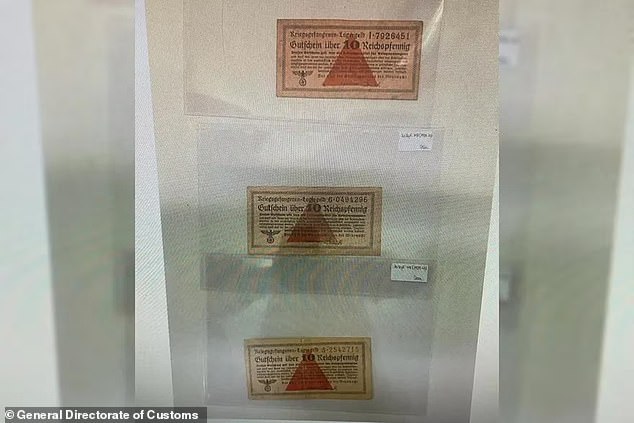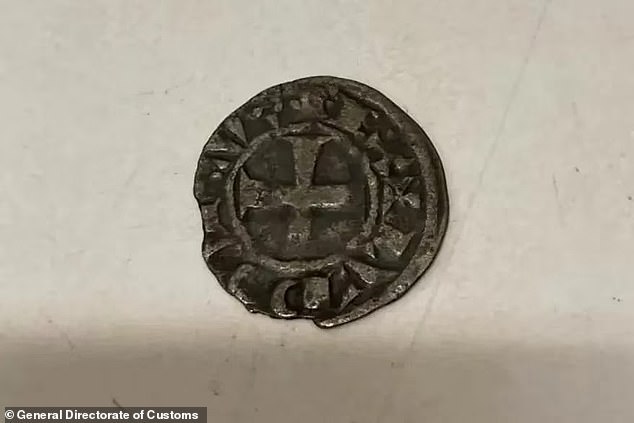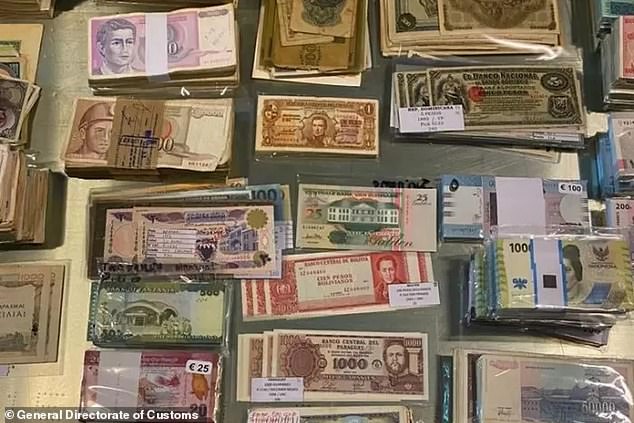Argentine customs agents seize $120.00 in currency, including bills used in the Nazi camp
>
Argentine customs agents seize $120.00 in currency, including bills used in the Nazi camp
- The General Directorate of Customs of Argentina seized a massive collection of coins and banknotes, dating back to the 18th century.
- The stash was confiscated on Wednesday when a couple arrived from Uruguay on a ferry and lied that they were not carrying any valuables.
- The collection is valued at $120,000 and features two rare US $1.25 and $1.50 bills. each ticket is worth
A massive collection of coins and notes, including a stash that was used in Nazi camps, has been seized from a couple in Argentina.
The raid took place on Wednesday when a vehicle owner and his wife were approached for a routine inspection after they arrived on a ferry from Colonia, Uruguay, according to the General Directorate of Customs.
The collection, worth about $120,000, included Ukrainian and German banknotes that were the preferred currency in Nazi camps during World War II.
Authorities in Argentina were alerted by Interpol, which had previously singled out the Argentine man because it had three ongoing investigations for alleged crimes that had been committed. The man had also been investigated several months ago by customs agents in Argentina for importing a collection of coins.
A customs agent in Argentina separates a collection of notes and coins that he seized from a couple on Wednesday after they arrived on a ferry and claimed they had no assets to declare before an officer and sniffer dog made the discovery.

A sniffer dog that is part of Argentina’s General Directorate of Customs helped officers find a large collection of coins and bills, including currency used in Nazi camps during World War II.
A customs agent and a sniffer dog were called to search the vehicle after the couple confessed that they were not importing any products that needed to be declared to the agency.
Images released by the agency showed the K9 sniffing the front passenger seat area.
The agent raised suspicions when the dog detected the presence of possible contraband inside the trunk of the vehicle.
Customs agents inspected the couple’s luggage and discovered paper and coins from various countries.
Officers then searched a spare tire and found a larger cache of bills and coins.
Although the couple claimed they were the rightful owners of the collection, the stash was seized as part of the investigation.
One of the Nazi camp currency notes read: “This note is only valid as a means of payment for prisoners of war and can only be spent and received by them inside the prisoner of war camp or in the case of business days in purchasing offices expressly designated for this purpose.»
The note indicated that ‘it can only be exchanged for legal tender at the corresponding deposit management office. Violators, imitations and counterfeits will be penalized. Chief of the Supreme Command of the Wehrmacht.

German paper money that was used in the Nazi camps during World War II

An 18th century coin that was part of the currency of France during the reign of King Louis IV.

Argentine customs agents discovered a massive collection of currency, including an 18th-century coin from France.

The collection of bills and coins from various countries around the world that was confiscated from a couple in Argentina on Wednesday
The collection featured a 1909 Puerto Rican $5 bill, worth $1,750.
There was also a franc from the Caribbean island of Martinique, dated 1947, that was valued at $1,100. The French franc was the official currency of Martinique until 2002 when the country switched to the euro.
Agents also discovered two rare American paper bills, one for $1.25 and the other for $1.50. The bills were from 1862 and were worth $750 and $850, respectively.
There was also a 1 peso note from Chile, dated 1879, which was valued at $1,000.
Agents found several 18th century coins. One of the coins featured the crown of King Louis IV.
It is unknown if the couple faces any charges for introducing the large collection into Argentina.
